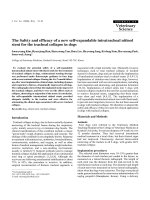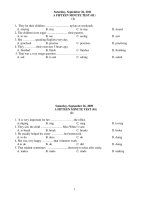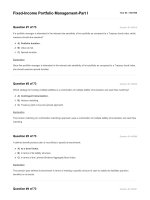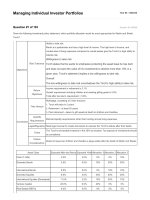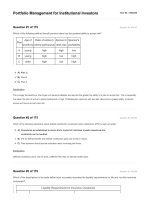Q a schweser self test 04 portfolio management for institutional investors question
Bạn đang xem bản rút gọn của tài liệu. Xem và tải ngay bản đầy đủ của tài liệu tại đây (151.84 KB, 3 trang )
Use the following information for Questions 1 through 6.
Rob Baker, an investment manager at Welker Auto Parts, is responsible for managing his company's
defined-benefit pension plan. The plan has been underfunded for several months and Baker is
meeting today with Gary Thompson, the company's CFO, to discuss possible ways to erase this
liability funding shortfall.
During the meeting, Baker and Thompson make a number of comments:
Comment 1:
Comment 2:
Comment 3:
Comment 4:
Baker proposes that the plan should increase the value of its pension assets by
investing in riskier securities. Currently, the plan invests a majority of its funds in
investment-grade corporate bonds and large-cap equities. Baker is confident that
investments in small-cap equities will help bring the fund back to fully funded
status.
Thompson is not confident that shifting to riskier securities will guarantee an
increase in pension asset values and points to the company's high debt ratio as an
indication of a need to take a more risk-averse stance.
Baker notifies Thompson of the high correlation of pension asset returns with the
firm's operations and states that the high correlation increases the ability to take
risk by increasing predictability.
Thompson disagrees with this statement, suggesting that a firm's high ratio of
active to retired lives diminishes the ability to take on more risk.
Baker and Thompson then turn to a list of additional discussion items:
Item 1: Add an option to the plan that will allow participants to retire five years earlier than currently
permitted at a 15% reduction in the value of the benefit payout..
Item 2: Adopt a liability mimicking approach to the plan's asset allocation instead of the current
asset-only approach.
Item 3: Freeze the plan. All new employees will participate in a new defined contribution plan where
employees can select from a list of investment alternatives that will range from more conservative to
more aggressive than the defined benefit plan.
Each item is independent and is to be considered in isolation, as if it is adopted and no other
changes are made.
As they are leaving the meeting Thompson mentions to Baker that the company founder is starting a
perpetual foundation to fund technical studies at a local community college. Thompson has been
asked to serve on the foundation's board.
................................................................................................................................................................
Question #1 of 6
Regarding Baker's Comment 1 and Thompson's Comment 2, which is most likely appropriate and
inappropriate:
Baker
Thompson
A) Inappropriate
Appropriate
B) Appropriate
Inappropriate
C) Inappropriate
Inappropriate
Question #2 of 6
Regarding Baker's Comment 3 and Thompson's Comment 4, which is most likely correct and
incorrect:
Baker
Thompson
A) Incorrect
Correct
B) Correct
Incorrect
C) Incorrect
Incorrect
Question #3 of 6
If the plan adopts the early retirement provision in Item 1, what is the most likely immediate effect on
the plan's liquidity needs and surplus?
Liquidity Needs
Surplus
A) Increase
Increase
B) Increase
Decrease
C) Decrease
No change
Question #4 of 6
The most typical result in a pension plan of adopting the liability mimicking approach in Item 2 is to
increase the allocation to:
A) equity and real rate bonds.
B) nominal and real rate bonds.
C) equity and alternative investments.
Question #5 of 6
Assuming Item 3 is adopted and that most plan participants choose more aggressive assets than
those in the pension plan portfolio, risk for the sponsor (Welker Auto Parts) will most likely:
A) increase.
B) decrease.
C) be unchanged.
Question #6 of 6
In contrast to a typical defined benefit plan, a foundation's risk and return objectives are likely to be:
Risk Tolerance
Return Objective
A) Higher
Higher
B) Lower
Higher
C) Lower
Lower


